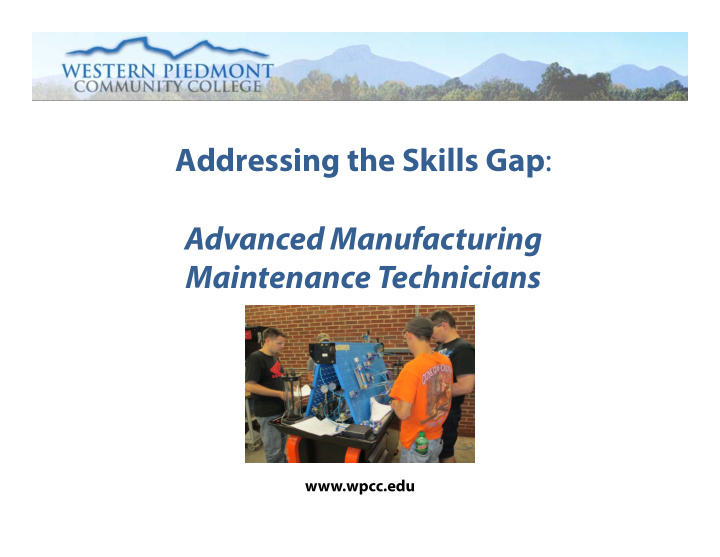



Addressing the Skills Gap : Advanced Manufacturing Maintenance Technicians www.wpcc.edu
Why the Skills Gap in Maintenance? National trend • Aging workforce • Lack of interest in manufacturing among • young adults Reluctance of unemployed individuals to • work in manufacturing Advances in manufacturing technology • Rising demand for advanced skills • www.wpcc.edu
Addressing the Skills Gap: The WPCC (et al) Approach Employer provided students • Authentic learning • Focus group of maintenance professionals that lead • the design of the curriculum Learning outcomes were defined by the industry • partners Pre-selected employees • Instructors who are practitioners and traditional • faculty Team Approach to Instruction • Utilized strengths of a diverse group of instructors • www.wpcc.edu
The Partners Western Piedmont Community College Provided instructional space, equipment, supplies and paid instruction Burke Manufacturers Executive Council Served as catalyst for focus group Valdese Weavers Leviton / Southern Devices Provided assistance with instructors Assisted with curriculum development Assisted with curriculum development Provided employees Provided employees Caterpillar Sypris Technologies Assisted with curriculum development Assisted with curriculum development Provided employees Provided employees www.wpcc.edu
Why is it Different, Innovative or Unique? Curriculum was developed by a cross section of manufacturers who • identified common skill gaps The class is structured as open enrollment to allow maximum flexibility for • working adults Students attend either day or night classes as their schedules permit • A blended learning approach is used: • Theory • Hands ‐ on • On ‐ line • The ability to articulate completion of the CE class to CU credits • www.wpcc.edu
Impact and Outcomes • 95% Success Rate! (for a 16 week – 96 hour course) • Both completers and companies reported a high level of satisfaction with the course. • The partner companies requested the class be offered again in the Spring and Summer of 2014. • The program was blended with the NC Back to Work program to allow for unemployed individuals to participate. • The current class consists of approximately 50% incumbent workers and 50% NC Back to Work students. • Additional partners participated in the second round. www.wpcc.edu
How the Program was Funded • Customized Training Project Funds • Regular Occupational Extension Funds • Company Investment • NC Back to Work • Burke Development, Incorporated www.wpcc.edu
Lessons Learned • Post course de-briefing meeting. • Companies shared their individual experiences and perceptions. • Curriculum was revised to include specific topics that the company partners deemed important. • The idea that providing maximum flexibility for working adult learners would result in a high success rate was supported by the outcomes. • Social Network of a mixed class was beneficial to both students and employers. www.wpcc.edu
Instructors’ Experiences • Instructors were concerned that many students believed that they were not “college material.” • Many students did exhibit a lack of self-confidence in their abilities. • Instructors reinforced the idea that the students were capable of success in a college level course. • 100% of completing students earn college curriculum credit. • At least one student has already entered an AAS curriculum program. www.wpcc.edu
Recommend
More recommend